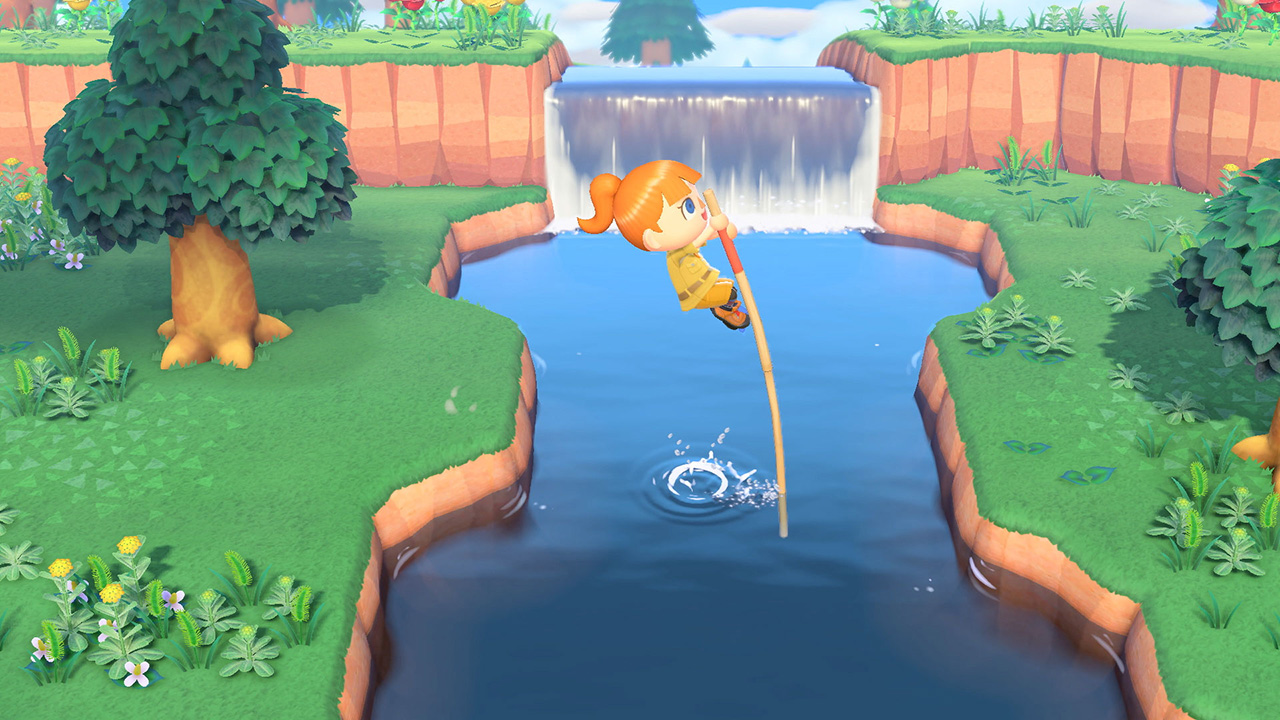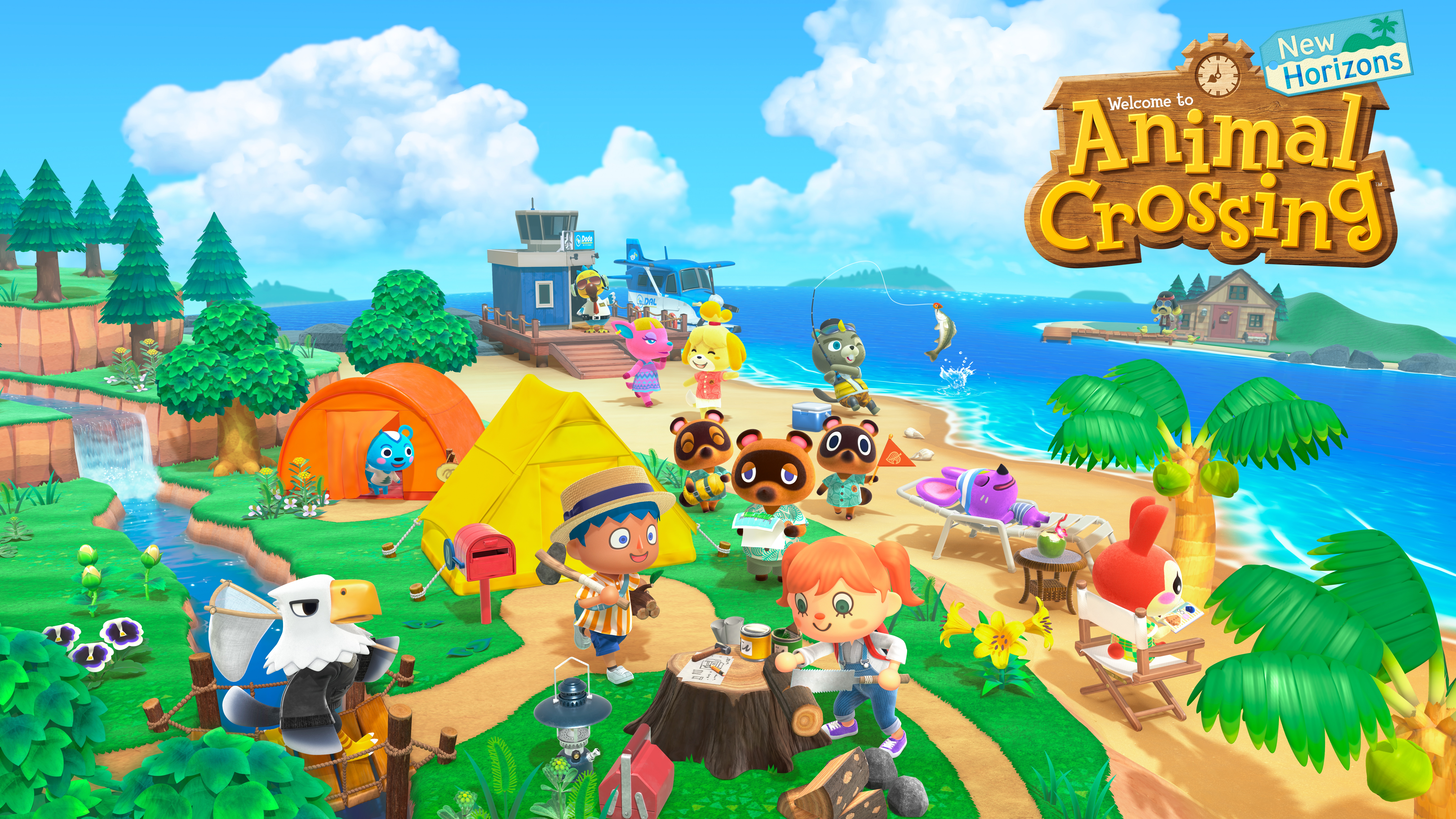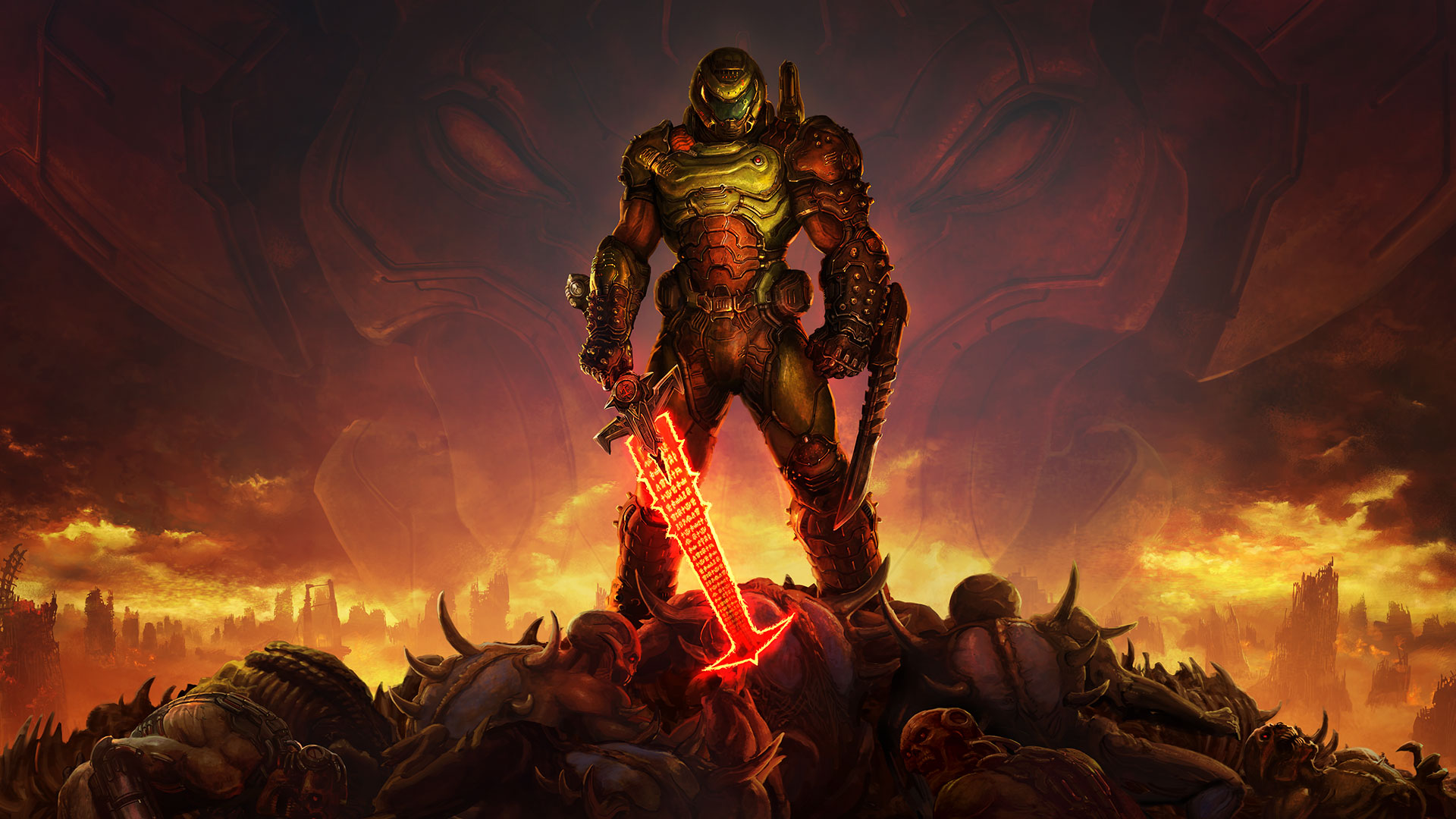This review was originally posted on April 2, 2020.
Communities are a fickle thing. When it comes to games, they can make or break the accessibility of a game. Games like Dark Souls often have a poor perception due to elitist communities that often gatekeep the games they represent. Animal Crossing is a series whose fundamental design is pillared around the idea of community. Not necessarily the community of die-hard fans that play the games, but rather the community that you build within your own village within the game itself. A large portion of people, myself included, have been eagerly anticipating the release of the latest entry in the franchise which also marks its return to the standard console platform. While there was definitely an adjustment period for the game when compared to similar titles like Starfew Valley, Animal Crossing: New Horizons is a completely unique game with a warm and welcoming atmosphere in a time where we really needed it.
To get an understanding of what Animal Crossing: New Horizons is, I need to abandon my standard review structure. The game doesn’t tell a singular story in and of itself. In fact, it doesn’t really tell a story at all. An immediate intended narrative is not what New Horizons focuses on at all and instead, the focus is shifted to the stories you build and the relationships you create with the various characters you may meet. Each player has their own favourite and least favourite villagers for a variety of reasons ranging from their cute appearance to a gift being thrown away. New Horizons is somehow the most realistic community simulator in existence while remaining completely detached from the conventional ideas of a community/society. There’s a completely fabricated economy that is so stable it almost seems like a paradoxical allegory to the very real and unstable economy that we all have to live with. The detached nature of the game, in conjunction with its well-realised world and charming atmosphere, allows you to become completely immersed in a title where immersion would seem like an afterthought (at a cursory glance). Spending hours in this game doesn’t leave you with a sense of regret as though you’ve wasted a colossal amount of time, instead, New Horizons leaves you with a sense of elation. No matter how much you do or don’t do in a day, there is never any pressure from the characters or the game’s systems. You are left to tackle things at your own pace.

Sourced from Nintendo
Pace and progress are probably the biggest learning curves that New Horizons has to offer for any new players and it is by far the one thing that took the longest for me to wrap my head around. My background for games of this style mainly consists of Stardew Valley, a game that I originally thought shared enough similarities to support my understanding of New Horizons’ central mechanics. Needless to say, I was mistaken. While both games aim for a similar end result, the method they apply is wildly different.
Stardew Valley is a game that mixes the realities of a farming simulator with an increased pace for more instant gratification. The loop involves managing your in-game days to balance farming, mining and interacting with the town. New Horizons is the polar opposite of this and its pace and progress are a slow burn. And I mean slow burn in the best way possible, which feels a bit weird to say. New Horizons doesn’t specifically ask anything of you, and you could very easily enjoy the game from the get-go without getting any of the upgrades that come as a part of the core progression of the game. All that New Horizons does is give you the tools necessary to craft a memorable experience through the player-driven collection and what is effectively an empty sandbox to play with and to this end, it hits a mark that no other game can. The game doesn’t force players into anything because it doesn’t need to. If players want to spend hours catching bugs and selling them for a quick buck, who are you to deny them of that? Want to go fishing for hours? You absolutely can, though it may not be ecologically sustainable. There is still a core progression path that most (if not all) players will follow during their time playing New Horizons and it’s the pacing of this progression that can lose some people.
Like I said earlier, Stardew Valley is a game about near-instant gratification and so, paradoxically, New Horizons’ slow burn progress consists of a smooth, constant drip-feed of gratification. Most main points of progress are tied to the day/night cycle. Your island basically stops most of its activity at around 10 PM, as that’s when the last store closes (once you have the stores). It’s in these lull periods where the brilliance of New Horizons’ simplicity shines. The game still doesn’t stop you from spending your time collecting bugs and fish, planting trees and flowers, clearing out forested areas and moving/placing furniture exactly where you want it to be. If anything, these lull periods give you even more freedom as you no longer feel the need to make use of these stores for economic and resource purposes, at least until the break of the new day. Town activity doesn’t start back up until 5 AM and this is where one of the biggest game systems can stumble people. Important processes like building house extensions, adding bridges, building houses for other villagers, moving infrastructure and even getting items delivered in the mail from the Nook Stop takes a day. Now, the game is very careful in its wording with this to make sure that it doesn’t mislead the player. While it is true that most things will take a day (or more) when it comes to what actually tracks the time for this, it is tracked via the tick of the new day which occurs at 5 AM like previously mentioned. Everything will be done by tomorrow and not in X amount of hours. What this means is players could start something big like moving their house at 3 AM and it’ll be done in two hours. While it may seem like nothing, this continuously gives the player the feeling that the town in which they reside is rhythmic in nature when it comes to big projects. It’s really cool and it also means that players almost always have something to wake up to in the morning.

Sourced from Gameranx
In saying this, there is one major flaw with the design and it comes forth during the period where the Nook Tent is being upgraded to the Town Hall. The Nook Tent is where most of the game’s progress stems from as building infrastructure and upgrading your house can only be done via Tom Nook within the Nook Tent. When upgrading the Nook Tent, which is a natural point of progression that requires no financial or resource investment, Tom Nook is inaccessible. This means that any semblance of progress or your ability to do anything beyond the basic tasks will be limited until the Town Hall has finished construction. This lasts for two days and, let me tell you, they were some of the longest two days I’ve ever experienced (and I had to play Anthem for a few weeks). This is pretty much the only time where New Horizons’ day-by-day progression can be a frustrating ordeal. Even when the main store is being upgraded for two days, there is still plenty for you to do.
One of the most important things to do in New Horizons is visit Mystery Islands. As you play through the game, you will earn Nook Miles by completing a variety of activities that range from the mundane, like gathering wood, to the extravagant, like spending thousands of Bells at the store. The game makes it a point to tangibly reward you for doing almost anything and, in giving you Nook Miles, you are given one of the most valuable resources in the game. Nook Miles are used for practically everything, whether it be purchasing upgrades for your backpack or buying a lighthouse to place on your island. This reward system is the hook, line and sinker for New Horizons’ core gameplay loop. The simplicity of the gameplay and the gratifying nature of being actively rewarded for playing the game creates satisfaction that turns into an itch that can only be cured by more satisfaction. Seriously, Nintendo has basically just given me virtual crack.
Let’s get back to the Mystery Islands. One of the items you can purchase using Nook Miles is a Nook Miles Ticket, a single-use item that allows you to visit a random island to gather resources in the hopes of finding something that you may not have on your own island. It could be a certain kind of fish or a different fruit to what’s native on your island. There are a number of possibilities within the Mystery Islands themselves and players have found some really cool islands (like Tarantula Island).
New Horizons creates a consistently zen atmosphere throughout the entire time you play. The music is bright, the characters are bubbly and there is never any form of tension in the atmosphere and gameplay. The art and animation communicate this perfectly. There are so many details put into the game that it’s quite impressive. Little things like a little animation on villagers’ houses in the morning when the bells ring on the turn of the hour, drawing the curtains and such. There is just so much life within this small virtual community that you feel lifted up as a result; the game hammers home the concept of belonging and purpose through welcoming the player and any associated quirks. The bright colour palette and simple shading mixed with gorgeous lighting create the effect that your island is pristine but at the same time it shows the beauty of you, the player. Little things just make everything feel so complete. Characters like Blathers and Isabelle react to your actions, so celebrating things like paying off debts or catching fish in front of villagers will get you an applause and some criminally adorable smiles from your associates. The game makes a point of positive reinforcement and the elation you feel from this is incredible. The easiest way to describe this feeling is fulfilling. I always find myself just at complete ease with the music and happy with doing anything in the game then I turn the game off and realising what a hell my life is.

Sourced from Animal Crossing World
One of the biggest additions to the Animal Crossing series with New Horizons is terraforming. Originally shown in a Nintendo Direct that focused on the cute community-sim, terraforming allows the player to completely change the shape and landscape of their islands. Whether you want a super flat island for easy town planning or a more vertically inclined island filled with cliffs and waterfalls, the terraforming tools put the power into the player’s hands and let their creativity run wild. These tools are by no means perfect, since you can only edit one tile at a time and it can be an incredibly finicky process to make pronounced environmental features, but it’s still nice to be able to change things to better suit your vision. Things like path-making could definitely stand for improvement as there are some restrictions of yesteryear that make no sense (like not being able to make diagonal paths). The terraforming tools feel like the only place where the simplistic charm on Animal Crossing can become cumbersome. Great ideas can quickly turn into laborious, time-consuming projects that may not even pan out how you would like.
Since community is at the heart of Animal Crossing as a whole, it makes complete sense that New Horizons features a way to interact with your friends and people within your given communities (like Twitch, for example). The online aspects of the game are, once again, incredibly simplified but work well enough. You can open up your island to people on your Nintendo Switch account’s friends list or you can generate a code for anyone to gain access to your island. There are restrictions that pertain to the in-game friends list, which exist independently of the Switch friends list. Anyone visiting your island instantly gets marked as an in-game friend but they are not given full permissions for your island. Instead, marking a friend as a best friend will grant them nearly full permissions on your island, outside of moving furniture and accessing the Nook Stop.
Most of the online systems are fine and I haven’t had too much of an issue with this; the system of opening your island is a great little way to give players choice in how they play rather than force-feeding unnecessary mechanics onto the players. The issues with online play are more a matter of net code and desyncing issues rather than anything to do with the mechanics themselves. To put it bluntly, the net code is barely half-functional. Instead of keeping a constant track of players’ progress while connected to one another, the game makes a note to autosave every few minutes. This is pretty problematic when one person’s Switch enters sleep mode or someone’s internet drops out. I’ve had half my inventory reset and fish not normally available to me lost because of my hemisphere’s poor internet. It can be frustrating, especially because connection dropouts are often out of your control.
Musically, New Horizons is near perfect. There are a number of songs that play throughout the day that range from a light, calming tone to a more upbeat but still relaxing melody. The music fits every scenario perfectly and there is no better way to complement the general laid-back feeling of this game than with the music. There is no air of tension and there is no dissonance. Just pure, bright bliss. This simple, easy-to-follow music can act as the catalyst for properly organising your daily routine within the game since audio cues can be some of the most powerful tools for adhering to a routine. Part of game composition is in understanding the human psyche and how you can manipulate it to better serve the intended goal of your game, and while it does sound weird to say that something as lighthearted as Animal Crossing is manipulating you, its intentions are light and wholesome.
- Conclusion
- Animal Crossing: New Horizons is a game that can be hard to get into for some, while an instant and gratifying addiction for others. The lighthearted nature of the game allows for it to become one of the most relaxing and distracting games on the market in a time where people could really use that distraction. Its main goal is to make the player feel as good as possible and, to this end, it achieves this goal with flying colours. New additions like terraforming are imperfect but welcome nonetheless because channelling the player’s creativity is one of the many ways that Animal Crossing positively reinforces the player. The addictive gameplay loop propped up by the Nook Miles system fits the game well by rewarding players for doing practically anything. I don’t think we will see another game like this for quite a while.
- Nintendo Switch







